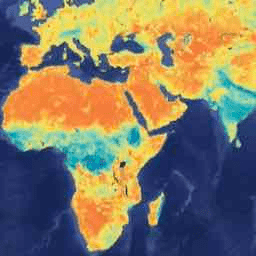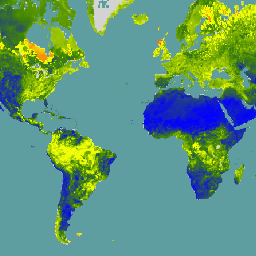-
GRIDMET 干旱:美国本土干旱指数

此数据集包含从 4 公里日网格化地面气象 (GRIDMET) 数据集中派生的干旱指数。提供的干旱指数包括标准化降水指数 (SPI)、蒸发干旱需求指数 (EDDI)、标准化降水蒸散指数 (SPEI)、帕默干旱严重程度指数 (PDSI) 和帕默… 气候 美国本土 作物 干旱 蒸发蒸腾 地球物理 -
KBDI:Keetch-Byram 干旱指数

Keetch-Byram 干旱指数 (KBDI) 是一种连续的参考尺度,用于估计土壤和腐殖质层的干燥程度。每逢无雨天,该指数都会增加(增加幅度取决于当天的最高气温);下雨时,该指数会下降。此系统… 干旱 火灾 降雨 -
SPEIbase:标准化降水蒸散指数数据库,版本 2.10

全球 SPEI 数据库 (SPEIbase) 提供了全球范围内有关干旱情况的长期可靠信息,像素大小为 0.5 度,频率为每月一次。它提供 1 到 48 个月的 SPEI 时间尺度。标准化降水蒸散指数 (SPEI) 以标准化变量的形式表示… 气候 气候变化 干旱 蒸发蒸腾 全球 每月 -
SPL3SMP_E.005 SMAP L3 Radiometer Global Daily 9 km Soil Moisture

NASA/SMAP/SPL3SMP_E/006 集合中提供了自 2023-12-04 起的数据。此 3 级 (L3) 土壤湿度产品提供由土壤湿度主动被动 (SMAP) L 波段辐射计检索到的全球陆地表面状况的每日合成数据。此处显示的每日数据是从降序(本地… 干旱 美国宇航局 SMAP 土壤 土壤湿度 地表 -
SPL3SMP_E.006 SMAP L3 辐射计全球每日 9 公里土壤湿度

2023 年 12 月 4 日之前的数据可在旧版 NASA/SMAP/SPL3SMP_E/005 集合中找到。这些图片最终会重新处理并添加到此合集中。此 3 级 (L3) 土壤湿度产品提供由土壤湿度主动被动 (SMAP) L 波段检索到的全球陆地表面状况的每日合成数据。 干旱 美国宇航局 SMAP 土壤 土壤湿度 地表 -
SPL4SMGP.008 SMAP L4 全球 3 小时 9 公里地表和根区土壤湿度

SMAP Level-4 (L4) 土壤湿度产品包括表层土壤湿度(0-5 厘米垂直平均值)、根区土壤湿度(0-100 厘米垂直平均值)和其他研究产品(未经过验证),包括地表气象强迫变量、土壤温度、蒸散和净辐射。此数据集正式称为… 干旱 美国宇航局 SMAP 土壤 土壤湿度 地表 -
TerraClimate:全球陆地表面的月度气候和气候水文平衡,爱达荷大学

TerraClimate 是一个数据集,其中包含全球陆地表面的月度气候和气候水文平衡数据。它使用气候辅助插值,将 WorldClim 数据集中的高空间分辨率气候平均值与 CRU Ts4.0 和日本 55 年再分析 (JRA55) 中的较低空间分辨率但随时间变化的数据相结合。… 气候 干旱 蒸发蒸腾 地球物理 全球 梅赛德 -
美国干旱监测

美国干旱监测图每周四发布,显示美国境内出现干旱的地区。该地图使用五种分类:异常干旱 (D0),表示可能正处于干旱期或刚结束干旱期的区域;以及四种干旱程度:… community-dataset drought noaa precipitation sat-io usda
Datasets tagged drought in Earth Engine
[null,null,[],[],["The provided data includes several datasets related to drought and soil conditions. SPEIbase offers global drought information with monthly updates and varying time scales. GRIDMET DROUGHT provides various drought indices, including SPI and SPEI, for the US. TerraClimate offers monthly global climate and water balance data. SMAP datasets (SPL3SMP_E and SPL4SMGP) detail daily and 3-hourly soil moisture, while KBDI estimates soil dryness. The US Drought Monitor weekly maps US areas affected by drought, classifying them into different drought levels.\n"]]
